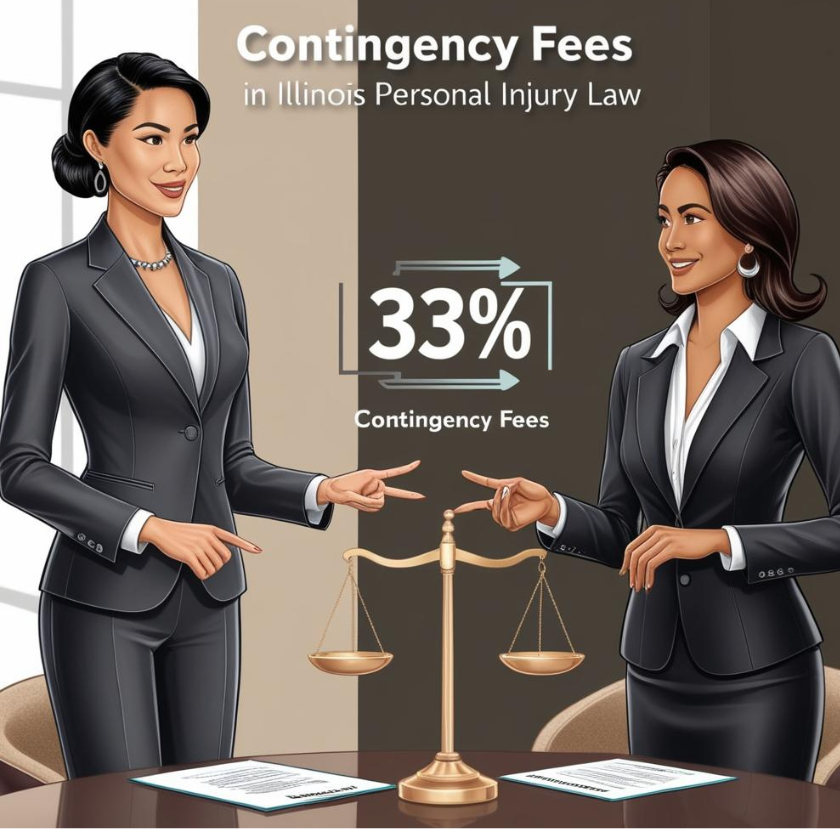When faced with the need to hire a lawyer, many people wonder, “how much does a personal injury lawyer cost in Illinois?” Though some professionals are used to hiring lawyers and have a vague idea of what to expect for attorney’s fees, most people rarely need an attorney. When they do, they like to have an idea of the cost before setting up a consultation. In a previous article, I already addressed the cost of a probate lawyer in Illinois; in this article, I will address the cost of a personal injury lawyer in Illinois.
First, I will break down the two main components comprising the expense of hiring a lawyer: “fees” and “costs.” I will then address common formulas used by personal injury attorneys to calculate fees. After that, I will provide an example to illustrate a common scenario. When reading, keep in mind that in injury cases, my firm is paid fees and costs from winnings, so there is usually little up-front out-of-pocket cost to the client.
Understanding the Difference Between Fees and Costs
When you meet with a personal injury attorney, he or she will discuss both attorney fees and case costs. The attorney fee is the amount of money paid to a lawyer for his or her labor. In contrast, case costs are money paid to third parties.
Personal injury cases can have a wide range of case costs, depending on the type of case. Some common costs include the following:
Court filing fee: The clerk of court charges a fee in order to file a lawsuit. This fee goes to support court operations and varies based on the size of the case. As of 2025, the filing fee is typically about than $388.00 in personal injury cases in Chicago.
Summons fee: The Sheriff charges a fee to serve a defendant with summons. This fee varies by county. In Cook County, it is about $60.00 per defendant per attempt. If the court allows a private investigator to be used, the fee tends to be a little less.
Subpoena and document fees: A party issuing a subpoena for documents must pay a statutory rate to the party receiving the request for documents. The total amount is usually small unless a massive number of documents are requested (as can be the case in medical malpractice).
Witness fees: Witnesses for trial and deposition (a pre-trial interview) are entitled to a statutory fee based on how far they have to travel to attend. This fee is usually less than $100.00.
Jury fee: If a jury is requested, a fee of between $100.00 and $230.00 is charged by the court.
Court reporter fee: Court reporters charge a fee for recording testimony during depositions (oral interviews under oath), and in some counties, the party must also provide his or her own court reporter at court. These reporters charge an “appearance fee” of around $300.00, which is a fee for showing up in court or attending a deposition and taking a transcript. Additionally, they charge a fee for preparing the transcript if requested. A cost of $4.00 to $6.00 per page is common depending on how quickly it must be prepared.
Expert fees: Expert fees include compensation for the time that medical treatment providers and other hired experts spend reviewing a case, testifying or appearing in court. Experts are very expensive and often charge hundreds of dollars per hour. Expert fees are usually the most substantial cost in an injury case and should be taken into careful consideration before hiring an expert.
There are many other case costs that may arise in a personal injury case, but the above will provide an idea of some of the more common costs that are likely to arise.

How Much Is a Personal Injury Attorney’s Fee?
The fee that a personal injury lawyer charges his or her client is whatever is negotiated between the the lawyer and the client. Below I will discuss the different types of fees and then the predominate practice for personal injury cases.
Types of Fees
Flat Fee
A flat fee is a specific amount charged by a lawyer for completing a specific task. Flat fees are common in practice areas such as estate planning and immigration. For instance, a lawyer might charge a flat fee of $1,500.00 to draft a will. However, flat fees are almost never charged in personal injury cases due to their unpredictability.
Hourly Fee
An hourly fee is by far the most common way for a lawyer to be paid. The lawyer will keep track of the hours he or she spends on a case, and the client will pay the lawyer based on the amount of time spent multiplied by the lawyer’s hourly rate. Hourly fees are especially common in most areas of litigation (disputes between parties) as the amount of time that will be spent on a case is very unpredictable. Even so, hourly fees are uncommon in personal injury cases except when a positive outcome is unlikely or the injury is so slight that a percentage fee doesn’t make sense. Additionally, an hourly fee is often charged if a personal injury claim is brought under a law that makes the defendant pay the fee, such as nursing home neglect and police misconduct.
Percentage Fee
Almost every personal injury lawyer is paid a percentage fee. Many people call this a “contingency fee,” but this is not a strictly accurate use of the term. All percentage fees are contingency fees, but not all contingency fees are a percentage fee. When a lawyer charges a percentage fee, he or she is paid a percentage of the money recovered for the client. For instance, if an attorney settles a case for $30,000.00 and the attorney charges a 1/3 percentage fee, the attorney would be paid $10,000.00 of that settlement for his or her labor.
Blended Fee
Blended fees are becoming more common in some areas of law. These are usually litigation cases where there is a substantial amount of money in dispute but the attorney is not confident in a positive outcome and needs some guaranteed payment to take a risk on a case. The blend is often a percentage of recovery plus either a flat fee or a lower-than-market hourly fee.
Understanding a Contingency Fee
As mentioned above, personal injury lawyers usually use the term “contingency fee.” A contingency fee means that a particular type of fee is charged if a certain event happens. The triggering event is almost always winning or settling a case. When the contingency is triggered, it can actually trigger any type of fee—whatever the attorney and client have agreed upon.
For instance, an attorney and client could agree that the attorney will charge an hourly fee of $300.00 per hour contingent on recovery and not to exceed recovery. If the attorney works 10 hours on the case and the client agrees to settle the case for $5,000.00, the contingency would be triggered and the attorney would be paid $3,000.00 based on the hourly rate calculation. This type of agreement might be seen in a nursing home neglect case where the injury is too small to justify a percentage fee. Since the nursing home neglect statute provides that the nursing home must pay the attorney a reasonable fee, a contingency fee based on an hourly rate can make sense in these cases.
Much more commonly, a contingency agreement will trigger a percentage fee. In these cases, the attorney will receive a percentage of recovery if there is a victory or settlement.
Illinois Personal Injury Lawyers Usually Charge a Percentage Fee
In almost all cases, an Illinois personal injury lawyer will charge a percentage fee on a contingency basis. If the lawyer wins or settles the case, his or her fee will be a percentage of recovery.
Attorneys tend to charge a percentage fee that equals 1/3 – 40% of recovery if the case is not appealed. In cases that are appealed, a higher percentage is necessary. The biggest exception to this practice is for workers’ compensation cases where the fee charged is regulated by statute.
Though the practice of charging 1/3 – 40% recovery is predominant, it is not absolute. Attorneys can charge whatever fee they like, and attorneys may adjust up or down based on how busy they are, how good a case is, or how big a case is.
Contingency fees based on something other than a percentage are common in certain types of cases, usually those with fee-shifting (a statute says the loser has to pay the winner’s attorney fees). The attorney-client agreement in these cases will commonly say the attorney will be paid the greater of 1/3 of total recovery or an amount awarded by the court, whichever is greater.
In unusual circumstances, an attorney may also offer a non-contingent hourly fee or a blended fee for a personal injury case. Since few injury victims can pay an up-front fee, this practice is rare and often an indication that the case has significant weaknesses.
How Costs Are Paid
Though lawyers typically charge a fairly standard 1/3 – 40% contingency fee, the same cannot be said for how case costs are paid; there is more variation here.
The most common practice is for an attorney to advance case costs (paying them on behalf of the client) and then subtract them from the client’s portion of recovery if the case is successful. If the case is unsuccessful, the attorney typically does not pursue the case costs.
That said, some attorneys are only willing to risk their time on a case but not their money, so it is fairly common for a client to pay some or all case costs up front. This is especially true in smaller cases or cases where recovery is less certain.
Liens and Subrogation
Liens and subrogation rights are also an important class of claims to be aware of in a personal injury case.
In the injury law context, a lien is a person or company’s right to be paid from the proceeds of an injured party’s case. If the attorney takes a contingency fee, he or she will have a lien on the case. If the injured party switched lawyers, the previous lawyer will likely also have a lien. Additionally, there will often be liens by medical providers that have not been fully paid by the injured party or the injured party’s medical insurance company. Liens must be agreed upon before proceeds of a case can be distributed (and, ideally, before the case is settled). A good personal injury attorney can often negotiate a reduction in liens to obtain a more favorable outcome.
A subrogation right is typically a clause in an injured party’s contract with his or her health insurance carrier. The clause provides that if the insurer pays medical bills for an injury and the injured party later recovers money for that injury, the medical insurer has a right to be reimbursed. It is often wise to enter an agreement with the insurer before the case settles with the defendant, though there is more nuance to handling these claims than liens.
In order to claim proceeds from a case based on a lien or subrogation claim, the party claiming the right must provide proper notice. If notice is provided, the claim must be paid in accordance with the law. If a notice is not provided, the injured party needs to decide whether it is best to address the issue head-on or wait to see if the party will ever assert a claim. Addressing the issue head-on has the advantage of an attorney negotiating the entire claim and likely settling the bills for less than 100% of what the provider claims. Waiting for the provider to collect on the bill has the advantage of possibly never having to pay—this is particularly true of subrogation claims, which often fall through the cracks (lien-holders are much more diligent).
If a lienholder is being unreasonable, the injured party can ask the judge to adjudicate the claim. Though the judge may eliminate or reduce the lien, this does not reduce what the medical provider has a right to be paid under its contract with the injured party; it just prevents the provider from intercepting settlement funds.
The attorney for an injured party will take inventory of known and properly noticed liens and subrogation claims. If a tempting settlement is offered, he or she will attempt to negotiate with the holders of liens and subrogation rights to finalize their entire claims. This will help the client to understand how much of the settlement he or she will receive after fees, costs, and payments to medical providers, insurers, and prior attorneys.
Get the Fee Agreement in Writing
It seems kind of crazy, but attorney-client agreements do not have to be in writing. The exception to this is contingency agreements— Illinois Rule of Professional Conduct 1.5(c) requires that all contingency fees must be in writing, and the writing must set forth the method for calculating the fee, state the costs to be deducted from recovery, state whether costs are deducted before or after the fee is calculated, and state whether the client is responsible for any costs if he or she does not prevail.
As a general matter, do not hire an attorney that is unwilling to put the agreement setting forth the terms of service in writing. At best, this is evidence that the lawyer is lazy; at worst, it is a sign that the attorney might not be trustworthy. Though the vast majority of lawyers are extremely honest and trustworthy, some bad apples do exist.
Read any agreement presented to you, ask questions about provisions you do not understand, and request clarifying language if necessary. Do not sign something you do not understand, and do not leave the office without a copy of the signed agreement.
An Example of a Typical Personal Injury Fee
In this final section, I will provide a hypothetical case to demonstrate how fees and costs break down in a typical personal injury settlement.
One winter day, Sally is walking on State Street when she comes to the intersection of State and Washington. The signal turns to “walk” and she starts to cross the street. Suddenly, she hears a loud noise. The next thing she remembers was waking up in the hospital. Her husband is in the hospital room and tells her the police reported that a man named Jimmy was drunk and ran a red light, hitting her while she was in the crosswalk. Her husband also tells her that an ambulance took her to the hospital, and she has been diagnosed with a concussion and a broken femur.
Since Sally’s father was an attorney, she knows that it is important to speak with a lawyer as soon as possible. After she is discharged from the hospital, she makes an appointment to speak with an attorney at my firm. Sally brings her medical records and a copy of the police report to her appointment. Upon meeting the attorney, she goes over the facts of her case and the attorney examines the records. The police report includes a summary of the officers’ investigation, noting three witnesses who indicated Jimmy went through a red light and a notation that Jimmy was arrested for drunk driving. The report also indicates that Jimmy has insurance through State Farm.
After reviewing the case, the attorney informs Sally that the firm is willing to represent her on a 1/3 contingency fee calculated prior to the deduction of costs. All parties sign the agreement, and Sally is instructed to continue with medical treatment and report back to her attorney every two weeks.
While Sally is receiving treatment, the attorney provides State Farm with a notice of attorney lien, orders the insurer not to contact Sally directly, and requests a disclosure of Jimmy’s liability coverage limits. State Farm responds that Jimmy has $100,000.00 in coverage and communicates through Sally’s attorney from that point on.
Sally continues seeing her doctors as directed, and six months later, the doctors determine she has made maximum medical recovery. The attorney requests the medical records and bills, paying the hospital the statutory rate for compiling the records—it comes out to $300.00.
Sally provides her medical bills to her attorney, which consist of $20,000.00 paid by her health insurance company and $1,000.00 of chiropractic care that was not covered. The chiropractor has not been paid yet and has provided a proper notice of lien.
Additionally, Sally missed two weeks of work as a result of her injury, costing her $2,000.00 in pay. Fortunately, Sally’s injury has no permanent impact on her life.
Sally’s attorney negotiates with State Farm, but the company is unwilling to offer more than $30,000.00, so Sally elects to file suit. To file suit, a $388.00 filing fee is paid by the firm as well as $60.00 to the sheriff to serve the summons. The sheriff is successful with service and depositions are set for Sally and Jimmy.
Each deposition is held, and Sally’s attorney advances $300.00 for the court reporter fee for Jimmy’s deposition. No transcripts are ordered.
After the depositions, State Farm engages in further negotiations. It offers $70,000.00 and Sally is ready to move on, so she asks her attorney how much she would receive if the offer was accepted.
Sally’s attorney speaks with her health insurer since it is entitled to subrogation under the insurance contract and Sally does not want anything left unresolved. The healthcare insurer agrees to settle its claim for $11,000.00. The chiropractor says he will not release his lien for anything less than full payment.
To calculate how much Sally will receive, her attorney first reduces the offer by 1/3 to account for his fee, leaving $46,666.66 to pay Sally, costs, and claims by the insurer and chiropractor.
Sally’s costs at this point total $1,048.00 and the liens and subrogation total $12,000.00.
After everything is accounted for, Sally’s attorney informs her that she will recover $33,638.66:
$70,000.00 gross recovery
-$23,333.33 1/3 attorney fee
-$1,048.00 case costs
-$12,000.00 subrogation and liens
$33,618.66 net recovery
Proceeds from a personal injury case are not considered income, so Sally will receive this money tax free.
This example is a fairly typical situation with the most common fee agreement. It is rare for an attorney to charge less than 1/3 of gross recovery (except where mandated) and there are quite a few situations where an attorney would charge more or even charge a different fee type. Many times, health insurers do not properly protect their subrogation claims, but Sally wanted finality so she elected to negotiate and pay the claim rather than wait for the insurer to assert it.
Summary
With the exception of a few statutorily regulated areas, an attorney and client are free to negotiate whatever fee they would like to agree to. In practice, most personal injury attorneys in the Chicago area charge 1/3 of gross recovery on contingency. If a case is not attractive enough for a personal injury attorney to take on a 1/3 contingency basis, the attorney can negotiate a higher fee, a blended fee, or even a normal hourly free. That said, many attorneys will assume the client is only looking for a contingency fee based on a percentage of recovery and outright decline to take any case that doesn’t qualify.
The case costs are almost always taken from the client’s portion of the recovery, so the client should be mindful of significant case costs. Payment of expert fees and testimony fees to medical providers are usually the most significant by far.
Injured parties should ensure that the agreement with their attorney is in writing, that they understand everything in the agreement, and that the agreement addresses all of their concerns. Injured parties should never rely on oral agreements.
If you would like to speak with an injury attorney, you can click this link and fill out a short form to request a consultation.



